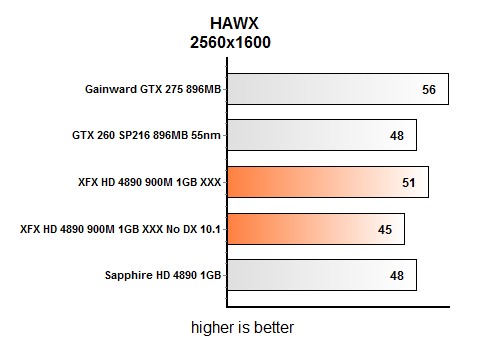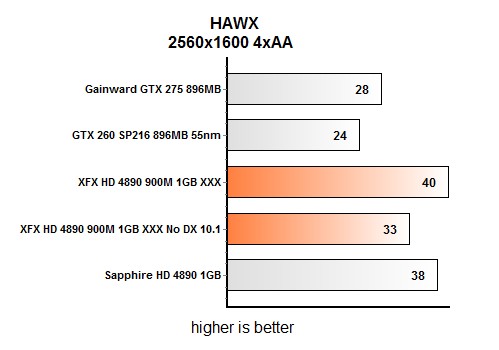Index


Review: HD 4890 and GTX 275 offer great bang per buck
Our today's guest is Geforce GTX 275, the card announced on the same day as AMD’s Radeon HD 4890. These two cards promise to be fierce competitors, and if you’re planning on splashing out about €220 to buy a graphics card for gaming, any of these two will surely do you good.
While HD 4890 is currently AMD’s best single-GPU card, GTX 275 found its place between the GTX 260 and Nvidia’s fastest single-GPU card – the GTX 285. GTX 275’s GPU is made in 55nm, has 240 shader processors, uses 448-bit memory interface, and comes with 896MB of GDDR3 memory.
Gainward is one of the first Nvidia partners to come up with a nonreference GTX 275 card. Their card has a completely different PCB and cooling, and our today’s guest runs at reference clocks. GPU runs at 633MHz, the memory at 1134MHz and the shaders at 1404MHz.
GTX 275’s clocks are much higher compared to the GTX 260’s 575MHz core, 999MHz memory and 1242MHz shaders. Speed-wise, the GTX 275 is much closer to the GTX 285 where the GPU runs at 648MHz, the memory at 1240MHz, and the shaders at 1476MHz. In order not to jeopardize the GTX 285’s lead, Nvidia ended up using the 448-bit memory interface and 896MB of memory, whereas the GTX 285 uses the 512-bit memory interface and 1024MB of memory. Also, the GTX 285 has 32 ROP units whereas the GTX 275 has 28.

Unlike the reference card with dual slot cooling and one fan, Gainward uses two fans in order to maximize cooling efficiency and provide silent operation. We’ve already seen this cooling on some Gainward’s GTX 260 cards and we must admit it cools well and runs silent. Furthermore, if we compare it to the one on the HD 4890, we must admit it’s significantly quieter.

The cooler houses two large 8cm diameter fans connected to the 4-pin connector via one cable, and rpm regulation is a breeze. Note that both fans run at same speed.

Underneath the fan is a large heatsink with three heatpipes, and the plastic hood that holds the fans in place covers the entire card.
The picture below reveals that power components are cooled with a separate black heatspreader. Two fan design used by Gainward is efficient, but the heat released from dissipation surfaces stays in the case, whereas reference cooling pushes it out. This however should not be a problem if your in-case airflow is adequate.

The heatsink with three heatpipes is in direct contact with only the graphics core.

The picture below shows the three heatpipes going from the copper base to different parts of the heatsink. GTX 275 temperatures are higher than on the GTX 260, but Gainward’s cooling keeps them in check.

All 14 memory chips are on the front of the card, and are cooled by touching the aluminum block.

The card features a 448-bit memory interface, compared to the 512-bit on the GTX 280. Such a strange number is a direct result of disabling one ROP partition. The equation is pretty simple – each of the 8 ROP partitions on the GTX 280 is connected to the 64bit memory controller, and after a simple multiplication you’ll get the final number – 512. Since the GTX 275/260 has 7 ROP partitions, the same equation results in the 448-bit memory interface. Each of the memory controllers houses two memory chips, so the GTX 260 needs 14 chips to reach the 896MB capacity. One ROP partition comes with 4 ROP units totaling at 28 ROPs for the card.

The memory in question is Samsung’s 0.8ns memory, used by Gainward on their GTX260 GS and GTX260 GS GLH cards. This memory is rated at 1200MHz, and despite running at 1134MHz on the GTX 275, you’ll see that it’s easily overclockable to 1200MHz+.

Gainward used non-reference PCB with 4+1 phase PWM design. You may have noticed that the memory power components were moved to the opposite end of the card.

The card is powered via two 6-pin PCI-Express power cables.
The I/O panel features two dual-link DVIs and an S-Video out. Using the DVI-to-HDMI dongle, you’ll be able to bring video only to your HDTV, so if you want both video and audio you’ll have to bring sound to your graphics card first via a SPDIF cable.


The card comes with Realtek’s voltage regulator, which unfortunately doesn’t support software voltage adjusting.

Gainward GTX 275’s packaging is no different from GTX 260 or GTX 285’s. As a gift, you’ll get an activation code for 3D Mark Vantage.
All the accessories are in the box. DVI-to-HDMI dongle, DVI-to-VGA dongle, one power cable with dual 4-pin Molex-to-6-pin PCI Express adapter, TV out cable with HDTV support, SPDIF cable, driver CD and the user’s manual.
TestBed
Motherboard: MSI P45D3 Platinum ( Provided by: MSI );
Processor: Intel Core 2 QX9770 Extreme edition at 3.6GHz ( Provided by: Intel );
Memory: Corsair Dominator 12800 7-7-7-24 ( Provided by: Corsair);
HDD: WD VelociRaptor 300G 10,000RPM ( Provided by: SmoothCreation );
Driver: ATI_VistaWin7_Radeon_4890_8.592.1RC1_March26.exe
Nvidia_182.50_geforce_winvista_32bit_english_whql.exe
Vista 32 SP1
Our today’s test subject is Gainward’s BLISS GTX 275 card, with its ticker clocked at 633MHz. So, it’s a reference clocked card but with non-reference cooling and PCB.
In our tables we also included the results scored by one of the fastest GTX 260 cards – Gainward’s GTX 260 GLH card (650MHz GPU / 1,100MHz memory) which beat ATI’s new HD 4890 card in quite a couple of tests, but is currently priced higher than GTX 275 (which should change soon).
Futuremark Tests
3DMark06 reports the GTX 275 to be quite close to GTX 285’s results, and that the GTX 260 runs 8% slower.

At the most demanding, Xtreme configuration, Radeon HD 4890 manages to beat the GTX 260 but Gainward’s GTX 275 leaves the latest AMD ace behind by as much as 20%. Another Gainward card broke 5k in Xtreme test, and it’s the GTX 260 Golden Sample Goes Like Hell, and it certainly justifies its name.



Gaming
Far Cry 2
FarCry2 reveals good framerate at extremely high resolution for both the HD 4890 and GTX 275, which speaks volumes of the cards’ muscle. HD 4890 handles the game pretty well, but GTX 275 shows its true colors at the highest resolution where it excels. At 1920x1200 and 2560x1600, Geforce GTX 260 and GTX 275 cards are not that dominant, but when the filters are on, Radeon HD 4890 has a hard time competing.








Left 4 Dead
With filters off, the HD 4890 wins all up to the 2560x1600 resolution, but at the highest tested resolution with filters on, Gainward GTX 275 emerges a winner. The overclocked XFX HD 4890 defends the new Radeons’ honor by winning at all but the highest resolution with filters.








World in Conflict
At reference clocks, the GTX 275 and Gainward GTX 260 GS GLH scored evenly a few times, but this should be considered maximum that GTX 260 can give. We expect to see overclocked GTX 275 cards which will surely build an even greater advantage over the GTX 260 and close in on the GTX 285’s results.
This test shows the GTX 275 running up to 19% faster than the HD 4890, whereas the resolution 2560x1600 shows 15% better results.
Radeon HD 4890 clearly brings antialiasing boost compared to the HD 4870. At 1920x1200 the performance difference between these two cards is mere 4%, but after turning antialiasing and anisotropic filters on, the difference jumps to 11%.
While the GTX 260 spent Left4Dead testing chasing the HD 4890, World in Conflict reports the opposite. It took AMD 1920x1200 resolution to catch up with the GTX 260, and the highest tested resolution, 2560x1600 even sees it win by 2%. XFX HD 4890 XXX beats the reference GTX 260 by 7% at the same resolution.








Tom Clancy's H.A.W.X
Thanks to XFX’s HD 4890 900M XXX test card we’ve received a few days ago, we got a chance to include Tom Clancy’s H.A.W.X, which comes as a gift with this card. Note that this is only one of the titles with DirectX 10.1 support.
Our tests reveal that HD 4800 scores much better with DirectX 10.1 than without it. At 2560x1600 with no DX10.1 support, the card scores 45 FPS, whereas turning on DX10.1 support results in the same card scoring 51FPS.
At 1920x1200 with no AA and DX10.1 support, it scores 62FPS whereas DX10.1 support results in 70FPS. The same resolution with no AA and DX10.1 support sees XFX score 58FPS, whereas turning on DX10.1 results in 57FPS. We’re talking about 10-15% difference, which is quite a hefty advantage.
Nvidia’s cards don’t feature DX10.1 support, so you won’t find an option to turn it on. Still, Gainward GTX 275 does well and beats the HD 4890 with no AA.




Temperatures
Gainward’s card features non-reference dual slot cooling with two fans and heatpipe technology, which keeps the temperatures on BLISS GTX 275 lower than on the reference cards. Compared to the GTX 260 we have slightly higher operation temperatures, but idle temperatures are better. The GTX 260 has a lower-clocked core, which results in lower workload temperatures.
The new HD 4890 card uses improved HD 4870 cooling and this time comes with more copper for that extra cooling muscle. Although the core has been overclocked from 750MHz on the HD 4870 to 850MHz, the temperatures are still lower than on the previous card. On the other hand, Nvidia didn’t manage to produce a cooler card.

Overclocking

Gainward’s cooling kept the temperatures in check during our overclocking, and we measured only 1°C more compared to not overclocked card. The fans were louder, but they were still not as loud as on the HD 4890.
We managed to score better than the GTX 285, and it took the highest tested resolution and enabled filters for the GTX 285 to reclaim its throne.




Consumption
The GTX 275’s consumption is higher than on the HD 4890, but thanks to more efficient 2D/3D operation mode, Geforce cards are usually more efficient in idle mode, as Radeons keep the 3D memory clocks in idle mode as well.

Conclusion
Gainward BLISS GTX 275 is a great card that will have no problem chewing up any game even at resolutions ff 30’’ monitors. Speed-wise, we’d put it closer to the GTX 285 than GTX 260, and overclocking will help you in getting the results of the much pricier GTX 285. This card is faster than Radeon HD 4890 and it costs about €20, and we must admit that the price difference concurs with the superior performance it has put in today.
BLISS GTX 275 comes with non-reference dual-slot cooling with heatpipe technology, and it keeps the core at maximum 85°C, whereas idle mode results in temperatures of 40°C. The cooler comes with two controllable fans that aren’t too loud during operation.
Priced at about €225, Gainward BLISS GTX 275 is a card we’d recommend to anyone craving gaming at 1920x1200 or higher. So let us recap - superior performance, good thermals and noise levels, excellent overclocking potential and for many the most important - great pricing for a high end card is what makes this card a Fudzilla recommended piece of equipment. Don't forget that the HD 4890 is also a great card, albeit a bit slower, but then again, it's also cheaper.

